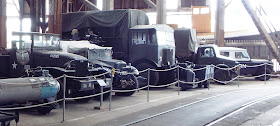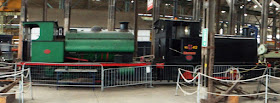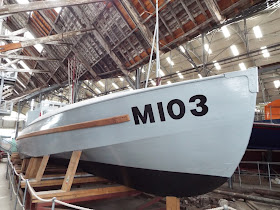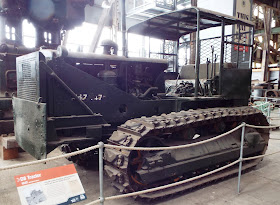Besides the exhibits covered in my earlier blog entries about The Historic Dockyard, Chatham, Kent, the museum has numerous 'one off' items on show that are less easy to group together or to categorise.
These 'odds and ends' include ...
Royal Navy soft-skin motor vehicles
0-4-0 Locomotives
XE-8 Miniature Submarine
This miniature submarine was built for the Royal Navy in 1944 by Thomas Broadbent of Huddersfield. It was used operationally in the Far East, and was sunk as a target off Portland in 1952. It was salvaged in 1973 and is believed to be the only example of an XE-class miniature submarine in existence. XE-8 now forms part of the Imperial War Museum's collection.
CMB 103 Coastal Motor Boat
Wooden coastal motor boats had been used during the First World War and had proven very successful. This example was built by Camper and Nicholson, Southampton, in 1920, and was designed to be used as a fast minelayer or torpedo boat. In the latter case she could be armed with up to six torpedoes. The hull was built of mahogany and featured a stepped hydroplane shape.
On completion CMB 103 went into reserve, and remained there until 1942. CMB 103 was then brought out of reserve and saw active service in the English Channel from 1942 until 1944, including service during the D-Day landings. She was laid up again at the end of 1944, and eventually displayed at the entrance to the former Coastal Forces Base (HMS Hornet) at Haslar, Gosport. CMB 103 now forms part of the Imperial War Museum's collection.
Westland Dragonfly Helicopter
The Westland WS-51 Dragonfly helicopter was built by Westland Aircraft and was a license-built version of the American Sikorsky S-51. From 1950 onwards the Royal Navy used their Dragonfly helicopters in the air-sea rescue role, and it remained in use until it was replaced by the Westland Whirlwind helicopter in the late 1950s.
QF 3.7-inch Anti-aircraft Guns
The QF 3.7-inch anti-aircraft gun was Britain's main heavy anti-aircraft gun during World War II. It was mounted on either mobile or fixed mountings, and nearly 10,000 were produced between 1937 and 1945. It remained in service with the British Armed Forces until the late 1950s, when it was replaced by anti-aircraft missile systems.
VIC 56 Victualling Inshore Craft
The Victualling Inshore Craft were used by the Royal Navy as supply vessels in almost every port and anchorage used during the Second World War. The design was based upon that of the Clyde 'Puffer', and 98 of them were built to the orders of the Ministry of War Transport between 1941 and 1945. She was laid up and put up for disposal in September 1978, and then bought for preservation.
VIC 56 was built in Faversham, Kent, and launched in 1945. By 1947 she had been allocated to the Victualling Store Officer, Rosyth, and stayed in the Rosyth are for the next thirty years of her active service. Her first long-term berth was in Rotherhithe on the Thames, from where she later moved to at Trinity House Buoy Wharf, near the East India Dock. In late 2005 VIC 56 was moved to her current berth in The Historic Dockyard, Chatham, Kent.
Of particular interest is the fact that when she was built, VIC 56 was fitted with a boiler that was of a convertible coal/oil design. Due to the high coast of diesel oil, her boiler has now been converted to be purely coal-fired.
These 'odds and ends' include ...
Royal Navy soft-skin motor vehicles
0-4-0 Locomotives
XE-8 Miniature Submarine
This miniature submarine was built for the Royal Navy in 1944 by Thomas Broadbent of Huddersfield. It was used operationally in the Far East, and was sunk as a target off Portland in 1952. It was salvaged in 1973 and is believed to be the only example of an XE-class miniature submarine in existence. XE-8 now forms part of the Imperial War Museum's collection.
CMB 103 Coastal Motor Boat
Wooden coastal motor boats had been used during the First World War and had proven very successful. This example was built by Camper and Nicholson, Southampton, in 1920, and was designed to be used as a fast minelayer or torpedo boat. In the latter case she could be armed with up to six torpedoes. The hull was built of mahogany and featured a stepped hydroplane shape.
On completion CMB 103 went into reserve, and remained there until 1942. CMB 103 was then brought out of reserve and saw active service in the English Channel from 1942 until 1944, including service during the D-Day landings. She was laid up again at the end of 1944, and eventually displayed at the entrance to the former Coastal Forces Base (HMS Hornet) at Haslar, Gosport. CMB 103 now forms part of the Imperial War Museum's collection.
Westland Dragonfly Helicopter
The Westland WS-51 Dragonfly helicopter was built by Westland Aircraft and was a license-built version of the American Sikorsky S-51. From 1950 onwards the Royal Navy used their Dragonfly helicopters in the air-sea rescue role, and it remained in use until it was replaced by the Westland Whirlwind helicopter in the late 1950s.
QF 3.7-inch Anti-aircraft Guns
The QF 3.7-inch anti-aircraft gun was Britain's main heavy anti-aircraft gun during World War II. It was mounted on either mobile or fixed mountings, and nearly 10,000 were produced between 1937 and 1945. It remained in service with the British Armed Forces until the late 1950s, when it was replaced by anti-aircraft missile systems.
VIC 56 Victualling Inshore Craft
The Victualling Inshore Craft were used by the Royal Navy as supply vessels in almost every port and anchorage used during the Second World War. The design was based upon that of the Clyde 'Puffer', and 98 of them were built to the orders of the Ministry of War Transport between 1941 and 1945. She was laid up and put up for disposal in September 1978, and then bought for preservation.
VIC 56 was built in Faversham, Kent, and launched in 1945. By 1947 she had been allocated to the Victualling Store Officer, Rosyth, and stayed in the Rosyth are for the next thirty years of her active service. Her first long-term berth was in Rotherhithe on the Thames, from where she later moved to at Trinity House Buoy Wharf, near the East India Dock. In late 2005 VIC 56 was moved to her current berth in The Historic Dockyard, Chatham, Kent.
Of particular interest is the fact that when she was built, VIC 56 was fitted with a boiler that was of a convertible coal/oil design. Due to the high coast of diesel oil, her boiler has now been converted to be purely coal-fired.




























































